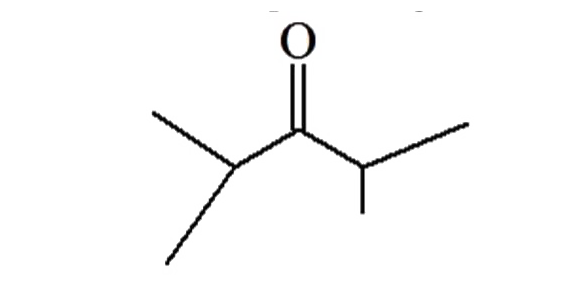In which compund D− exchange is possible in presence of OD−/D2O ?
The correct Answer is:1
To determine in which compound D-exchange is possible in the presence of OD⁻ and D₂O, we need to identify compounds that have acidic alpha hydrogens. These acidic alpha hydrogens can participate in the exchange reaction with deuterium.
1. Understanding D-exchange: D-exchange refers to the process where hydrogen atoms (H) in a compound are replaced by deuterium (D). This typically occurs at acidic alpha hydrogens adjacent to carbonyl groups.
2. Identifying Acidic Alpha Hydrogens:
- Acidic alpha hydrogens are those that can be easily removed as protons (H⁺) to form a stable carbanion or enolate.
- The presence of a carbonyl group (C=O) increases the acidity of the hydrogen atoms on the adjacent carbon (alpha carbon).
3. Analyzing the Options:
- Option A: CH₃C(=O)Ph (Acetophenone)
- The alpha hydrogens (H on the CH₃ group) are acidic due to the adjacent carbonyl group. Thus, D-exchange is possible.
- Option B: CH₃CH₂C(=O)Ph (Butyrophenone)
- The alpha hydrogens here (on the CH₃ and CH₂ groups) are not sufficiently acidic for D-exchange due to the lack of stabilization from the carbonyl.
- Option C: CH₂=CHC(=O)Ph (Vinyl phenyl ketone)
- The alpha hydrogens are on sp² hybridized carbons, which are not acidic enough for D-exchange.
- Option D: (CH₃)₂C(=O)Ph (Acetone derivative)
- The alpha hydrogens here are also not acidic enough to facilitate D-exchange.
4. Conclusion: The only compound that allows for D-exchange due to the presence of acidic alpha hydrogens is Option A: CH₃C(=O)Ph.
Final Answer:
The correct answer is Option A: CH₃C(=O)Ph (Acetophenone).
- Acidic alpha hydrogens are those that can be easily removed as protons (H⁺) to form a stable carbanion or enolate.
- The presence of a carbonyl group (C=O) increases the acidity of the hydrogen atoms on the adjacent carbon (alpha carbon).
- Option A: CH₃C(=O)Ph (Acetophenone)
- The alpha hydrogens (H on the CH₃ group) are acidic due to the adjacent carbonyl group. Thus, D-exchange is possible.
- Option B: CH₃CH₂C(=O)Ph (Butyrophenone)
- The alpha hydrogens here (on the CH₃ and CH₂ groups) are not sufficiently acidic for D-exchange due to the lack of stabilization from the carbonyl.
- Option C: CH₂=CHC(=O)Ph (Vinyl phenyl ketone)
- The alpha hydrogens are on sp² hybridized carbons, which are not acidic enough for D-exchange.
- Option D: (CH₃)₂C(=O)Ph (Acetone derivative)
- The alpha hydrogens here are also not acidic enough to facilitate D-exchange.
The correct answer is Option A: CH₃C(=O)Ph (Acetophenone).
Topper's Solved these Questions
- BASIC CONCEPTSBook:RESONANCE ENGLISHChapter:BASIC CONCEPTSExercise:Inorganic chemistry (Periodic Table & Periodicity
Explore 27 Videos
- BASIC CONCEPTSBook:RESONANCE ENGLISHChapter:BASIC CONCEPTSExercise:ORGANIC CHEMISTRY(BASIC CONCEPTS)
Explore 27 Videos
- AROMATIC COMPOUNDSBook:RESONANCE ENGLISHChapter:AROMATIC COMPOUNDSExercise:Part - III Practice Test-22
Explore 1 Video
- BIOMOLECULESBook:RESONANCE ENGLISHChapter:BIOMOLECULESExercise:Advanced Level(Part II)
Explore 33 Videos
Similar Questions
In which of the following compound O18 exchange can be observed on keeping it in H2O18
View SolutionBolling point of D2O is
View SolutionAssertion , d5 configuration is more stable than d4
Reason : d5 has more exchange energy as compared to d4
because 10 & 6 exchanges are possible in d5&d4 respectively.
View SolutionWhich is true statement about D2O and H2O ?
View SolutionWhich of the following is not possible for 4p or 3d electrons?
View SolutionWhich of the following orbitals are possible ?
1p,2s,3f,3d
View SolutionWhich of the following is not formed in the below reaction
O3+Kl+D2O→
View SolutionNumber of Deuterium exchange in the given tautomer when the compound is kept in NaOD/D2O for a long time is :

View SolutionWhich of the following orbitals are possible ?
1s,2s,3f,3d
View SolutionAssertion: [Ti(H2O)6]4+ is coloured while [Sc(H2O)6]3+ is colourless.
Reason: d-d transition is not possible in [Sc(H2O)6]3+.
View Solution
